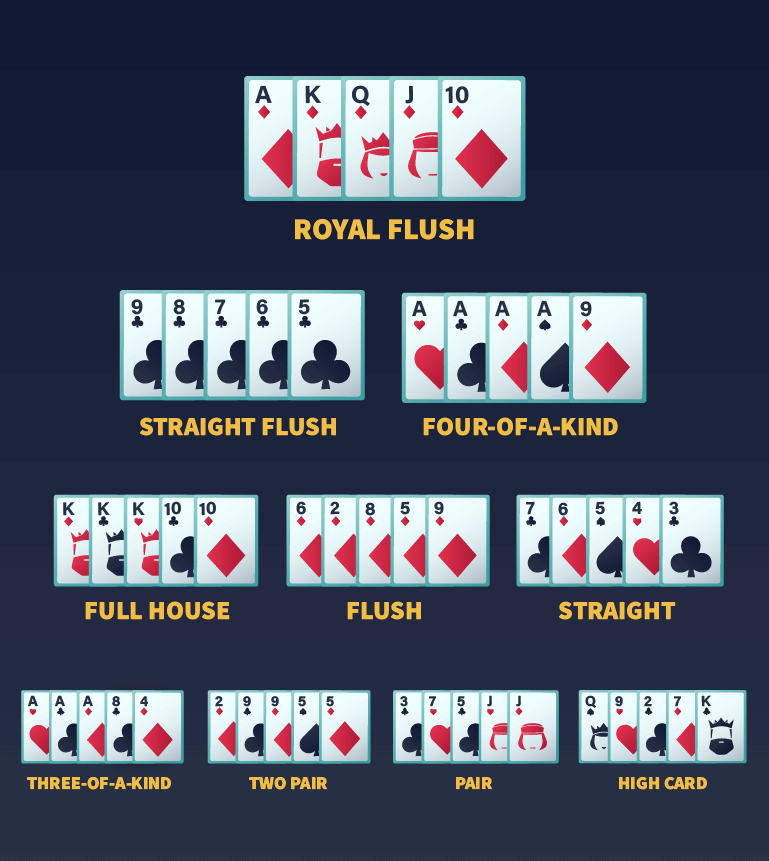What is a Poker Hand?
Poker hands are made up of five cards, and these five-card hands are ranked according to their statistical probability. Put simply, the poker rankings chart is based on how difficult it is to make specific five-card combinations.
For example, the probability of making a five-card combination containing a pair (i.e. two cards of the same value) is 42.25%. In comparison, there’s a 0.39% chance you’ll make a straight (e.g. 3-4-5-6-7) when five cards are dealt at random. Therefore, because a straight is less likely than a pair, it ranks higher on the poker hand chart.
Before I go any further, it’s important to explain that the way you make a five-card hand depends on the poker variant you’re playing. I’ll be using Texas Hold’em to illustrate the concept of poker card rankings because it’s the most popular variant in the world.
However, for clarity, each variant has its own poker rules. With this in mind, here’s how you make five-card hands in the main variants of poker:
Texas Hold’em
you receive two hole cards and have the option to combine one, two, or neither with any of the five community cards.
Omaha
you get four hole cards and must combine two of them with three of the five community cards.
Seven-Card Stud
you get seven cards and must use five of them. Three of your playing cards are dealt face-down, while four are dealt face-up so everyone on the table can see them.
Five-Card Draw
you receive five starting cards and have the option to hold or exchange as many cards as you wish before a second draw and a showdown.
Despite having different dynamics, each variant ranks poker hands in the same way. There are, however, some poker variants that have different hand rankings.
Do All Types of Poker Hands Rank the Same Way?
No, they don’t. There is a category of poker variants known as lowball games. I don’t play a lot of lowball poker, but certain variants are popular at the top online poker sites. Specifically, you’ll often be able to play 2-7 Lowball and Razz online.
These variants, like other lowball poker games, award pots to the worst hands, aka the lowest-value hand. For example, in Razz, the top-ranking hand is 5-4-3-2-A, irrespective of suits. This poker hand trumps all others because it’s the lowest straight possible.
Additionally, as is the case in most lowball poker hands, flushes don’t count. Basically, if you’ve got a hand filled with low-value cards, it’s got a good chance of winning a showdown.
Other Poker Variants
Lowball games aren’t the only ones that have their own poker card rankings. The following games also put a spin on the standard poker hand ranking chart:
Split-Pot Poker Variants
Split-pot poker variants are exactly what you’d expect them to be. The pots are split between the best high-value and best low-value hands. The most popular split-pot variant is Omaha Hi-Lo, which sees 50% of the pot go to the best hand according to a standard poker rankings chart and 50% go to the best lowball hand.
Exotic Poker Variants
Poker players are always trying to spice things up by tweaking the rules of traditional poker variants. These tweaks often include adding jokers and removing cards. A great example of this is 6+ Hold’em.
Overall, the game is identical to Texas Hold’em. The twist, however, is that all cards worth less than six have been removed from the deck. Removing these cards means it’s harder to make flushes than full houses.
This alters the poker hand rankings chart for 6+ Hold’em. Specifically, flushes rank as the fourth most powerful hand above full houses and straights. Under normal conditions, full houses are worth more than flushes.
Poker Hand Rankings Chart
I’ve already said that straights beat pairs, but what about other hands? Does a set beat a full house? What about flushes? The poker hand rankings table below has all the answers you need.
| Poker Hand Ranking | Poker Hand | Example |
|---|---|---|
| 1 (best) | Royal Flush | 10♦ J♦ Q♦ K♦ A♦ |
| 2 | Straight Flush | 4♠ 5♠ 6♠ 7♠ 8♠ |
| 3 | Four-of-a-Kind | A♠ A♦ A♥ A♣ K♥ |
| 4 | Full House | A♥ A♠ K♥ K♣ K♦ |
| 5 | Flush | 3♣ 5♣ 9♣ K♣ J♣ |
| 6 | Straight | 3♣ 4♥ 5♠ 6♦ 7♥ |
| 7 | Three-of-a-Kind | A♦ A♣ A♥ 4♠ J♦ |
| 8 | Two Pair | K♠ K♦ 7♣ 7♥ Q♦ |
| 9 | One Pair | J♥ J♣ 5♠ 3♥ 10♠ |
| 10 (worst) | High Card | 10♥ 2♦ 7♠ 4♣ 8♠ |
Odds of Making Hands in Poker
I said earlier that poker card rankings are based on probabilities. A good way to truly understand what this means is by looking at the probability of making specific hands. The tables below give you this information.
Poker Hand Odds
The table below shows the probability of making a hand if five cards are dealt randomly from a standard 52-card deck. For example, if you picked up a shuffled deck and dealt five cards from the top, there’s a 42.25% chance that the hand will contain a pair. If you want to learn more about poker odds in detail, I’ve also prepared a guide for this.
| Poker Hand | Probability of Making with Five Cards |
|---|---|
| Royal Flush | 0.000154% |
| Straight Flush | 0.00139% |
| Four-of-a-Kind | 0.024% |
| Full House | 0.14% |
| Flush | 0.19% |
| Straight | 0.39% |
| Three-of-a-Kind | 2.11% |
| Two Pair | 4.75% |
| One Pair | 42.25% |
Odds of Flopping Poker Hands in Texas Hold’em
The table below tells how often you’ll make each hand on the flop in Texas Hold’em. If you recall, everyone starts with two hole cards in Hold’em. The flop consists of three community cards. When you combine these cards, you get the following probabilities:
| Poker Hand | Probability of Hitting on the Flop in Hold’em |
|---|---|
| Royal Flush | 0.005% |
| Straight Flush (with suited connectors 5-4 to J-T) | 0.02% |
| Four-of-a-Kind (unpaired cards vs. pocket pair) | 0.03% vs. 0.24% |
| Full House (unpaired cards vs. pocket pair) | 0.09% vs. 0.98% |
| Flush | 0.8% |
| Straight (with connectors 5-4 to J-T) | 1.3% |
| Three-of-a-Kind (unpaired cards vs. pocket pair) | 1.35% vs. 11.5% |
| Two Pair | 2% |
| One Pair | 29% |
Poker Hand Rankings Chart Explained
OK, so you now know how hands are ranked in poker. It’s possible to memorise our poker hand ranking chart and become a profitable player, but the transition from newbie to pro might take a long time.

I want to reduce the amount of time it takes, which is why we need to delve into the nuances of each poker hand. I can’t cover every angle, but the following list should give you a general overview of what to do with each poker hand.
Royal Flush
Royal flushes are rare, so it’s not always wise to chase them. That being said, the benefit of chasing a royal flush is that you can make flushes, straights, and high-value pairs. Therefore, if you’re in a position to go for it, you’ve still got solid outs if you miss.
Straight Flush
The same strategy for playing royal flushes applies to straight flushes. If you get one, bet hard when possible and never fold because you’re basically not going to lose.
Additionally, if you chase a straight flush and miss, you can still make flushes or straights. The only downside is that any pairs you make might not be very strong. For example, if you chase a six-high straight flush but only make a pair of fours, that might not be good enough to win a showdown.
Four-of-a-Kind (aka quads)
It’s hard to hit four-of-a-kind, but you’ll notice from the table above that you’ve got a much better chance if you start with a pocket pair. In fact, your odds of making a strong hand get even better when you factor in three-of-a-kind (aka a set). So, my tip here is simple: only chase four-of-a-kind (and three-of-a-kind) if you’ve got a pocket pair.
Full House (aka a boat)
You’re over twice as likely to make a full house if you start with a pocket pair than an unpaired hand. Therefore, as you’ll have realised by now, the key to making full houses is to start with good cards. In this situation, good starting cards are pocket pairs.
Flush
Flushes are hands where all five cards share the same suit. In standard poker variants, suits aren’t ranked, which means hearts aren’t stronger than spades, clubs aren’t better than diamonds, and so on. In fact, if two players make a flush, it would be a split pot.
You can make a flush without two suited hole cards, but it’s much harder. One thing I’ll draw your attention to is the fact that you’ll get dealt suited hole cards approximately 25% of the time. Therefore, you’ll have plenty of opportunities to play for flushes. Just make sure your kicker is strong (more on kickers in a moment).
Straight
The key to making straights is, as you can probably guess, hole cards. The odds of flopping a straight with connectors are significantly higher than if you have unconnected cards. Specifically, if your hole cards give you four ways to make a straight, you’ll have a 1.3% chance of flopping one.
If your hole cards give you three or two possible ways to make a straight, the probability drops to 0.98% and 0.065%, respectively. The lesson here is to play connected cards with no gaps, e.g. 4-5, 8-9, J-10, rather than a hand like 3-7, because they give you a better shot at making straights.
Three-of-a-Kind
The same principles apply to three-of-a-kind hands as four-of-a-kind. To recap, it’s better to start with pocket pairs than unconnected cards. What I will say is that it’s important to distinguish between trips and sets.
Trips are when one of your hole cards connects with two on the board. Sets are when two of your hole cards connect with one on the board. You’ve made three-of-a-kind in both instances, but sets are more powerful because they’re less obvious. Therefore, you should be more confident of winning showdowns with sets than trips.
Two Pair
Playing two pair hands is a matter of kickers. For example, 2♠ 3♥ on a 3♠ 2♦ 7♣ K♥ Q♦ board is OK, but someone could easily have K-Q for a better two pair if it’s a raised pot. Therefore, you need to consider the value of your two pair in relation to other possible two pair hands, as well as all the other hands people could have.
One Pair
One pair hands are fine, but their value matters. A pair of aces is obviously better than a pair of deuces, which brings me back to the point about starting cards. The stronger your starting cards, the stronger your post-flop hands are likely to be.
Additionally, like two pair hands, you need to think about kickers. Making a pair of aces with A-7 is fine, but you could be out-kicked if it’s a raised pot. Why? Because people tend to have hands such as A-J, A-Q, and A-K in raised pots. If that’s the case, you’d lose with A-7 to A-J because of the kicker, i.e. a Jack is worth more than a 7.
Poker Hand vs. Poker Hand: Test Your Skills
Before I give you my final tip for playing poker hands, I want to put your newfound knowledge to the test. Below are three hand vs. hand showdowns. Without looking at our rankings chart, can you say what hand each player has made and who the winner is? The answers are at the very bottom of this page:
Hand 1
- Player A has A♠ K♥
- Player B has Q♠ Q♣
- Board: A♦ K♠ 8♣ 4♠ Q♦
- Result?
Hand 2
- Player A has 6♣ 7♥
- Player B has 9♥ 10♠
- Board: 4♥ 5♣ 8♠ 7♦ J♣
- Result?
Hand 3
- Player A has 10♥ 8♥
- Player B has 9♥ 3♥
- Board: 2♥ 3♠ J♥ 8♣ A♥
- Result?
How to Play Poker Hands Like a Pro
You can learn more about playing specific hands in my poker strategy guide. However, before I let you put your knowledge of poker card rankings into practice, I want to give you a few things to think about.
From a strategic perspective, I want you to see the poker hand rankings chart as more than a list. Viewed correctly, it can be a great way for you to improve your hand-reading skills. Let me explain: if you understand the rankings of hands and their statistical likelihood, you can get a better sense of what people might have.
Example Scenario
➡️ We know that you’ll make a pair on the flop 29% of the time in Hold’em. We can simplify this and say an opponent is likely to have a pair or better approximately 1/3 of the time.
- Based on this alone, there’s a greater chance an opponent has missed the flop than they’ve made a pair.
- Let’s say your opponent raises pre-flop and makes a standard continuation bet on an unconnected board i.e. there isn’t a chance they could have a full house, flush, straight, or two pair. An example of an unconnected flop would be 6♥ 10♠ A♦.
➡️ In this scenario, your opponent is representing a small range of hands. Specifically, a pair or three-of-a-kind.
- We know there’s a 29% chance they’ve hit a pair and an 11.5% chance they’ve hit three-of-a-kind (if they have a pocket pair).
- Therefore, based on probability, it’s more likely that your opponent currently doesn’t have anything.
Reading An Opponent’s Bet Using Poker Card Rankings
I must stress that this is a very simple example of how to use poker hands rankings to make decisions. You need to think about other things, such as betting patterns, position, and table dynamics, to make accurate reads.
That being said, you will have a better general understanding of how likely someone is to have certain hands if you know the poker hand ranking chart. When you combine the rankings with the odds of making specific hands on the flop, you’ll give yourself a better chance of making accurate reads from the start of a hand.
Poker Hand Rankings FAQs
While I’ve tried my best to be as thorough in my guide, I understand that poker hand rankings can be tough to grasp. If you need any clarification, please contact me or the NewCasinos team, and we will get back to you as soon as possible. In the meantime, you can also go through the list of frequently asked questions I’ve prepared below.
What’s the best hand in poker?
The best hand in poker is a royal flush, which is an ace-high straight flush. Specifically, a royal flush in poker is 10-J-Q-K-A with all of the cards sharing the same suit, e.g. 10♦ J♦ Q♦ K♦ A♦.
What are the odds of getting a royal flush?
The odds of hitting a royal flush in poker are 0.000154% across all streets. If you hold two suited broadway cards (e.g. Q♦ K♦), the odds of flopping a royal flush in poker are 0.005% if you’re playing Texas Hold’em.
What are the odds of getting a straight flush?
The odds of hitting a straight flush in poker are 0.00139% across all streets if we exclude royal flushes from the equation. If you hold two suited connectors (e.g. 4♦ 5♦), the odds of flopping a royal flush in Texas Hold’em are 0.02%.
Do I need to bet if I have a bad hand?
No, you’re under no obligation to play any cards you’re dealt. In fact, it’s often a good idea to wait for strong starting cards so that you’ve got a better chance of making ranked poker hands after the flop. It’s also important to note that you can also fold strong hands if you think an opponent has a stronger one.
How many poker hands are there?
There are 10 different hands you can make in poker. Each hand consists of five cards and is ranked according to its probability. The best hand in poker, which is also the hardest to make, is a royal flush. The worst hand in poker is a high card, which is a hand that hasn’t even made a pair. Therefore, if two players haven’t made a ranked hand, it’s a case of the highest card wins.
Does a flush beat a straight in poker?
Yes, a flush is better than a straight in poker. Flushes are five cards of the same suit. Straights are hands that contain five cards in sequential order, e.g. a sequence such as 2-3-4-5-6. It’s statistically harder to hit five suited cards than five cards in sequential order.
Daniel Smyth has been engrossed in the industry for the past 17 years, leveraging his English degree and love for poker into a booming career. His unique insights and engaging writing style, alongside his years of experience, make him a trusted name in the industry.
Fact-Checked by Dhalia Borg, Head of Content
9 minread



